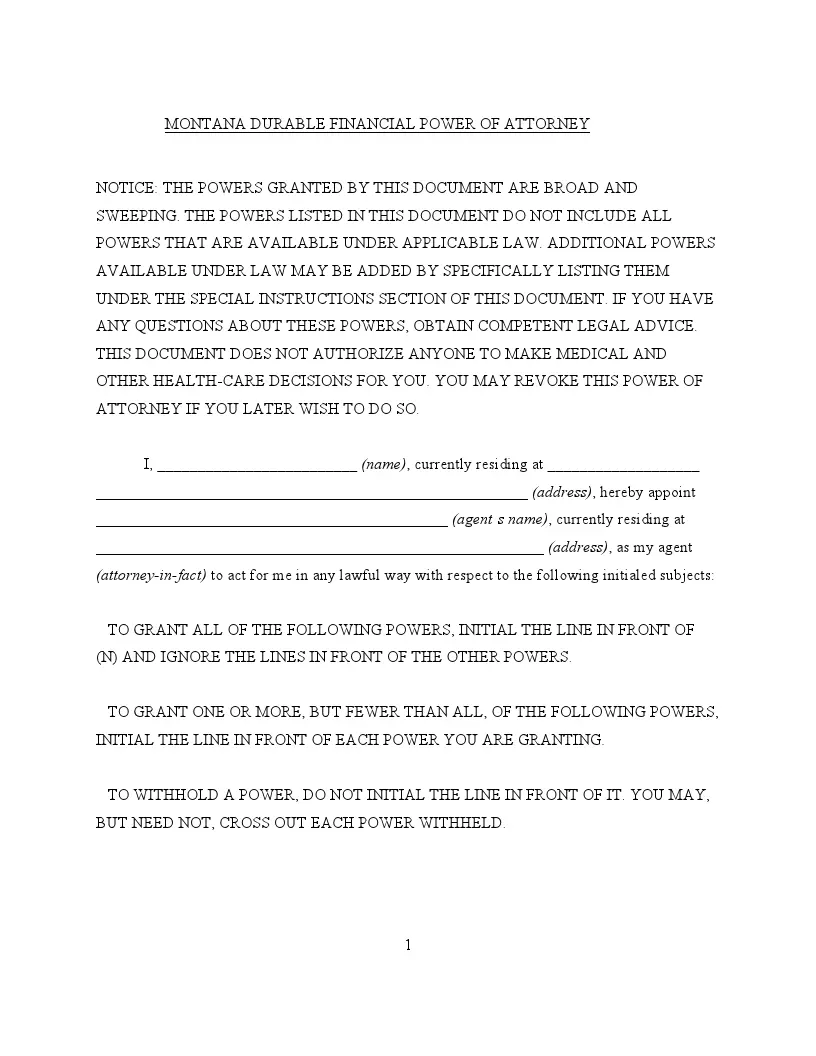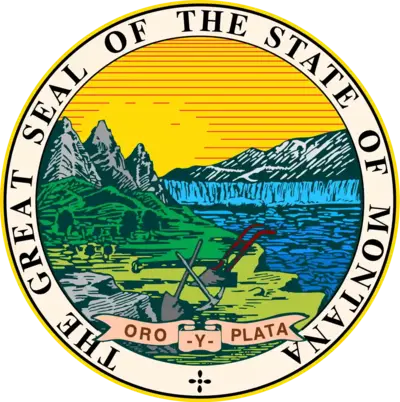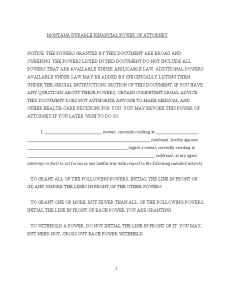Free Montana Durable Power of Attorney Form
The Montana durable power of attorney is a legally binding instrument that permits an individual (principal) to designate another person (attorney-in-fact) as their representative to manage their financial matters and make monetary decisions on their behalf. The hallmark characteristic of this type of power of attorney is its durability — it continues to be enforceable even if the principal becomes mentally incapacitated or incapable of making sound judgments independently.
The durable power of attorney form can confer wide-ranging authority to the appointed agent, such as conducting banking activities, engaging in real estate transactions, overseeing investment portfolios, submitting tax filings, and more. Alternatively, the principal retains the ability to limit the specific powers.
The agent assumes a fiduciary role and must act in the principal’s best interests. Responsibilities include maintaining thorough records and ensuring the principal’s assets remain separate from the agent’s holdings. To properly draft and execute these legal documents, use Montana POA templates.

Build Your Document
Answer a few simple questions to make your document in minutes
Save and Print
Save progress and finish on any device, download and print anytime
Sign and Use
Your valid, lawyer-approved document is ready
Montana Signing Requirements and Laws
In Montana, the requirements and provisions for a durable power of attorney are governed by the Uniform Power of Attorney Act, which has been adopted in some form by most U.S. states. To set up this document, you must choose a trusted person or institution as your agent, clearly outline the powers granted, and have the document executed under state laws. Here are some points about durable powers of attorney in Montana:
- Execution. The principal must sign a power of attorney in the presence of a notary public (§ 72-31-305, MCA).
- Durable provision. It must clearly state that the power of attorney is “durable” and will remain in effect if the principal becomes incapacitated.
- Effective date. It can be effective immediately upon signing or only upon the principal’s incapacity.
- Revocation. The principal can revoke the durable power of attorney as long as they are mentally competent (§ 72-31-310, MCA).
- Fiduciary duty. The agent has a fiduciary duty to act in the principal’s best interests.
A durable financial power of attorney can be an important estate planning tool in Montana. It allows someone to manage the principal’s affairs if they become unable to do so themselves due to illness or incapacity. However, it grants significant authority, so the agent should be highly trustworthy.
Montana Durable Power of Attorney Form Details
| Document Name | Montana Durable Power of Attorney Form |
| Other Names | Montana Financial Durable Power of Attorney, MT DPOA |
| Relevant Laws | Montana Annotated Code, Section 72-31-305 |
| Signing Requirements | Notary Public |
| Avg. Time to Fill Out | 10 minutes |
| # of Fillable Fields | 37 |
| Available Formats | Adobe PDF |
Popular Local Durable POA Forms
Durable POA documents are used in each and every state. Take a look at other popular DPOA forms frequently filled out by Americans.
Steps to Complete the Form
Filling out the Montana durable power of attorney form gives someone else the authority to handle your financial affairs. Here are detailed instructions to guide you through the process.
1. Introduction
The form begins with a notice emphasizing the broad and sweeping powers granted by this document. The principal (the person granting the power) must provide their name and address.
2. Appoint the Agent
In this section, you must provide the name and address of the person you appoint as your agent (attorney-in-fact). This is the individual who will handle your financial affairs on your behalf.
3. Grant Powers to the Agent
The form lists various powers you can grant to your agent. Initial the line in front of each power you wish to grant. If you want to grant all the listed powers, initial the line in front of “(N) ALL OF THE POWERS LISTED ABOVE.”
4. Special Instructions
This section allows you to provide additional instructions or clarifications regarding the powers granted to your agent. Read the pre-written instructions carefully and decide whether to include them or modify them according to your preferences.
5. Effective Date
You must choose and initial one of the three options provided, indicating when a power of attorney will become effective. The options are: immediately, on a specific date, or only upon your incapacity.
6. Exercise of Power with Multiple Agents
If you have appointed more than one agent, this section outlines how decisions will be made and how agents can act separately or together.
7. Successor Agent
In this section, you can name a successor agent who will take over if your initially appointed agent is unable or unwilling to serve.
8. Signature and Acknowledgment
After carefully reviewing the entire document, sign and date it in the presence of a notary public, who will then complete the acknowledgment section.

Listed here are various other Montana documents filled out by our users. Try our step-by-step builder to customize these forms to your needs.
Download a Free Montana Durable Power of Attorney Form
